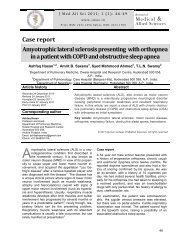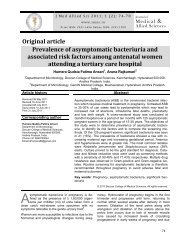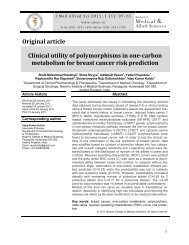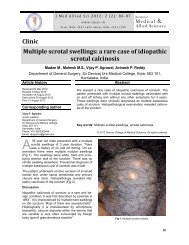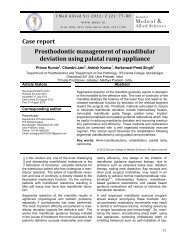Homology modeling and ligand interaction of human trafficking ...
Homology modeling and ligand interaction of human trafficking ...
Homology modeling and ligand interaction of human trafficking ...
Create successful ePaper yourself
Turn your PDF publications into a flip-book with our unique Google optimized e-Paper software.
J M e d A l l i e d S c i 2 0 1 1 ; 1 ( 1 ) : 2 1 - 24<br />
w w w . j m a s . i n<br />
P r i n t I S S N : 2 2 3 1 1696 O n l i n e I S S N : 2231 1 7 0 X<br />
Journal <strong>of</strong><br />
M e d i cal &<br />
Allied Sciences<br />
Original article<br />
<strong>Homology</strong> <strong>modeling</strong> <strong>and</strong> lig<strong>and</strong> <strong>interaction</strong> <strong>of</strong> <strong>human</strong><br />
<strong>trafficking</strong> protein particle complex subunit 3-like<br />
protein <strong>and</strong> its correlation with Alzheimer’s disease<br />
Venkata Sri Krishna K 1 , Uday Kiran M 2 , Siva Rama Prasad D 1 , Anusha G 3 ,<br />
Mohana Rao V 4 , Manoj G 1<br />
1 Department <strong>of</strong> Biotechnology, Aurora Technological <strong>and</strong> Research Institute, Hyderabad, A.P., India.<br />
2 Centre for Distance Education Bioinformatics, Osmania University, Hyderabad, A.P., India.<br />
3 Department <strong>of</strong> Pharmacy, Sarojini Naidu Vanitha Pharmacy, Nampally, Hyderabad, A.P., India.<br />
4 Scientist, Monco Biotechnologies, Ameerpet, Hyderabad, A.P., India.<br />
Article history:<br />
Received 16 January 2011<br />
Revised 25 January 2011<br />
Accepted 29 January 2011<br />
Early online 30 January 2011<br />
Print 31 January 2011<br />
Corresponding author<br />
Manoj G<br />
Assistant Pr<strong>of</strong>essor,<br />
Department <strong>of</strong> Biotechnology,<br />
Aurora College <strong>of</strong> Technological &<br />
Research Institute,<br />
Parvathapur, Uppal,<br />
Hyderabad- 39,<br />
Andhra Pradesh, India.<br />
Email : dhanmanu@gmail.com<br />
Phone: +91 9966660204<br />
Abstract<br />
In order to underst<strong>and</strong> the mechanism <strong>of</strong> molecular <strong>interaction</strong>s at<br />
active sites <strong>of</strong> <strong>trafficking</strong> protein particle complex (TRAPPC) subunit<br />
3-like protein (Accession number Q5T215) homology <strong>modeling</strong> <strong>and</strong><br />
docking studies were taken up. We generated a three-dimensional<br />
(3D) model <strong>of</strong> target protein based on the Crystal structure <strong>of</strong> Human<br />
BET3 protein (PDB code 1SZ7) using modeller s<strong>of</strong>tware. Under<br />
the process <strong>of</strong> homology <strong>modeling</strong> 25 models were generated,<br />
<strong>and</strong> the model having the lowest modeler objective function value<br />
was chosen for further assessment. The generated model was assessed<br />
<strong>and</strong> validated using PROCHECK s<strong>of</strong>tware <strong>and</strong> found to be<br />
reliable.<br />
With the generated model, we carried out a flexible docking study<br />
using the FlexX docking tool available on the Sybyl S<strong>of</strong>tware in order<br />
to find better antagonist site for drug binding. We carried out a<br />
flexible docking with the Palmatic acid <strong>and</strong> Donepezil as lig<strong>and</strong>s;<br />
these were found to bind at LEU87, LYS84 <strong>and</strong> THR90 residues on<br />
given generated protein in our studies. We therefore concluded that<br />
the above mentioned residues were the key residue sites for lig<strong>and</strong><br />
binding showing strong hydrogen bonding contacts.<br />
The target protein is more prevalently seen in the amygdala region<br />
<strong>of</strong> brain which forms one <strong>of</strong> the key subunit <strong>of</strong> TRAPP complex. As<br />
per functional similarity with BET3, target protein might play key role<br />
in <strong>trafficking</strong> abnormally folded A-beta <strong>and</strong> tau proteins along endoplasmic<br />
reticulum to Golgi apparatus there by leading to formation<br />
<strong>of</strong> senile plaques in various regions <strong>of</strong> brain, whose accumulation<br />
causes Alzheimer’s disease.<br />
Key words: homology <strong>modeling</strong>, docking, modeller, FlexX, PRO-<br />
CHECK<br />
© 2011 Deccan College <strong>of</strong> Medical Sciences. All rights reserved.<br />
J Med Allied Sci 2011;1(1)<br />
21
Krishna KVS et al.<br />
Human <strong>trafficking</strong> protein particle <strong>and</strong> Alzheimer’s disease<br />
T<br />
rafficking protein particle complex (TRAPPC)<br />
3-like protein is a peptide compound with<br />
181 amino acid residues which belongs to<br />
the family <strong>of</strong> BET3. The target protein plays an<br />
important role in vesicular transport mechanism<br />
between the endoplasmic reticulum <strong>and</strong> Golgi apparatus<br />
1,2 .<br />
The TRAPPC3 protein is expressed from BET3L<br />
gene located on Chromosome 6 at 6q22.1 3 . As per<br />
functional similarity target proteins participate in<br />
intracellular targeting; <strong>and</strong> transport <strong>of</strong> proteins in<br />
eukaryotic cells depends on a variety <strong>of</strong> proteins<br />
<strong>and</strong> protein complexes involved in the coating,<br />
budding, release, uncoating, tethering <strong>and</strong> fusion<br />
<strong>of</strong> vesicles. Vesicle budding commonly relies on<br />
formation <strong>of</strong> a protein coat around the bud <strong>and</strong> is<br />
initiated by the binding <strong>of</strong> a GTPase on the exit<br />
membrane 1,4 .<br />
The target protein is involved in coat-formation <strong>of</strong><br />
the various proteins that are expressed in intercellular<br />
compartments, which facilitates coated proteins<br />
to interact with membrane thereby leading to<br />
polymerization <strong>and</strong> stabilization <strong>of</strong> the bud <strong>and</strong><br />
subsequently to dissection <strong>of</strong> the vesicle from the<br />
membrane 4,5 .<br />
The 3D structure <strong>of</strong> target protein which was generated<br />
by using BET3 protein <strong>of</strong> the same family<br />
was subjected to docking studies in order to find a<br />
potent drug which can bind to active site <strong>of</strong> target<br />
protein <strong>and</strong> play a key role in antagonism. The<br />
modeled target protein is expected to be in better<br />
spatial conformation so that any lig<strong>and</strong> can be<br />
bound at active sites through which inhibition or<br />
activation can be achieved. For carrying out further<br />
docking studies with some more lig<strong>and</strong>s or drugs<br />
on modeled target protein, three important determinant<br />
residues LEU87, LYS 84 <strong>and</strong> THR90 were<br />
indentified in our study as potentially helpful. The<br />
motif region along the LEU87, LYS84 <strong>and</strong> THR90<br />
residues resembles a pocket like structure which<br />
enables us to carry out lig<strong>and</strong> <strong>interaction</strong>s with various<br />
potent drugs.<br />
Our study assumes that by designing such a potent<br />
drug with superior binding capacity on our target<br />
protein, one can improve signal transduction<br />
pathways. Thereby altered or regulated pathways<br />
might cure different neuronal disorders 6 .<br />
Materials <strong>and</strong> methods<br />
Sequence alignment <strong>and</strong> homology <strong>modeling</strong><br />
We performed sequence similarity search <strong>of</strong> target<br />
sequence using Blast tool which returned high<br />
scoring homologues sequences. Among the resultant<br />
hits, sequence with high E-value was chosen<br />
i.e., BET3 (PDB code 1sz7) to perform comparative<br />
sequence analysis <strong>and</strong> alignment with<br />
TRAPPC-3 using Clustal W tool. The program<br />
MODELLER9v1 was used for the Modeling 3D<br />
structure <strong>of</strong> target sequence. Modeller is an implementation<br />
<strong>of</strong> an automated approach to comparative<br />
<strong>modeling</strong> by satisfaction <strong>of</strong> spatial restraints<br />
7,8 . Accordingly twenty five models were<br />
generated using the loop refinement method <strong>and</strong><br />
the model having the lowest Modeller objective<br />
function was chosen for further validations.<br />
Model validation<br />
PROCHECK was used for the validation <strong>of</strong> the<br />
models generated. The main geometric parameters<br />
<strong>of</strong> the models were determined by PRO-<br />
CHECK 9 . Accordingly we have chosen the best<br />
model for further investigations based upon the<br />
most favorable features. In the last step <strong>of</strong> homology<br />
<strong>modeling</strong> the selected model was subjected to<br />
a series <strong>of</strong> tests for its internal consistency <strong>and</strong><br />
reliability. Backbone conformation was evaluated<br />
by the inspection <strong>of</strong> the psi/phi Ramach<strong>and</strong>ran plot<br />
obtained from PROCHECK analysis (Fig 1).<br />
Fig 1. Ramch<strong>and</strong>ran plot showing the <strong>human</strong> TRAPPC- 3 Model.<br />
The most favored regions are coloured red, additional allowed,<br />
generously allowed <strong>and</strong> disallowed regions are indicated<br />
as yellow, light yellow <strong>and</strong> white fields, respectively.<br />
Docking<br />
Molecular docking can fit molecules together in a<br />
favorable configuration to form a complex system.<br />
The structural information from the theoreticallymodeled<br />
complex may help us to clarify the binding<br />
mechanism <strong>of</strong> lig<strong>and</strong>s to the receptor. FlexX s<strong>of</strong>tware<br />
under Sybyl Operating System was the tool<br />
J Med Allied Sci 2011;1(1)<br />
22
Krishna KVS et al.<br />
Human <strong>trafficking</strong> protein particle <strong>and</strong> Alzheimer’s disease<br />
we chose to perform the automated molecular<br />
docking. All docking calculations were performed<br />
by the Lamarckian Genetic Algorithm (LGA) 10 . We<br />
ran LGA with default parameters <strong>and</strong> found insufficient<br />
sampling efficacy. Parameters <strong>of</strong> LGA were<br />
changed to obtain better result. These changes<br />
contributed higher diversity <strong>of</strong> sampled configuration<br />
<strong>of</strong> protein <strong>and</strong> allowed us to achieve sufficient<br />
sampling <strong>of</strong> the conformational space available for<br />
lig<strong>and</strong>s within the binding site (Fig 2A, 2B, 3A &<br />
3B).<br />
Fig 2A. Image showing docking <strong>of</strong> palmitic acid with target<br />
protein<br />
Fig 2B. Image showing docking <strong>of</strong> palmitic acid with target<br />
protein under ball <strong>and</strong> stick model<br />
Fig 3A. Image showing docking <strong>of</strong> donopezil acid with target<br />
protein<br />
Fig 3B. Image showing docking <strong>of</strong> Donepezil with target protein<br />
under ball <strong>and</strong> stick model<br />
Results<br />
<strong>Homology</strong> <strong>modeling</strong> <strong>and</strong> docking<br />
The final alignment <strong>of</strong> the TRAPPC-3 to that <strong>of</strong><br />
BET3 was carefully checked in TM regions. We<br />
found that all the critical structural elements involved<br />
in the binding <strong>of</strong> their natural substrates<br />
were intact. Therefore, we conclude that this<br />
alignment could be used to construct reliable 3D<br />
models. Validation <strong>of</strong> the homology models involved<br />
two independent tests. The first test was to<br />
compare the residue backbone conformations in<br />
our model with the preferred values obtained from<br />
the Protein Data Bank <strong>of</strong> known structures. The<br />
results <strong>of</strong> PROCHECK analysis indicate that none<br />
<strong>of</strong> the residues were falling under disallowed<br />
ranges <strong>and</strong> the quality <strong>of</strong> Ramch<strong>and</strong>ran plots is<br />
acceptable for generated model. The percentage<br />
<strong>of</strong> residues in the "core" region <strong>of</strong> modeled<br />
TRAPPC-3 was found to be 90.7. The stereo<br />
chemical quality <strong>of</strong> the models was found to be<br />
satisfactory.<br />
With the protein held static throughout the simulation,<br />
the antagonist molecule was manipulated to fit<br />
inside the cavity, largely by applying a r<strong>and</strong>om displacement<br />
to each degree <strong>of</strong> freedom, i.e., translation<br />
<strong>of</strong> its centre <strong>of</strong> gravity, orientation <strong>and</strong> rotation<br />
around each <strong>of</strong> its flexible internal dihedral angles.<br />
The docked complexes <strong>of</strong> receptor-lig<strong>and</strong> were<br />
selected according to the criteria <strong>of</strong> interacting<br />
energy combined with geometrical matching quality.<br />
Accordingly the binding confirmations were evaluated<br />
<strong>and</strong> ranked. The most probable residues<br />
involved in antagonist binding were determined<br />
using the evaluations <strong>of</strong> <strong>interaction</strong> energies. The<br />
Table I explains the docking scores <strong>of</strong> lig<strong>and</strong> <strong>interaction</strong><br />
with target protein.<br />
J Med Allied Sci 2011;1(1)<br />
23
Krishna KVS et al.<br />
Human <strong>trafficking</strong> protein particle <strong>and</strong> Alzheimer’s disease<br />
Table I. Docking scores <strong>of</strong> lig<strong>and</strong> <strong>interaction</strong> with<br />
target protein<br />
Compound<br />
Donepezil<br />
Interacting<br />
amino acids<br />
LYS 84,<br />
THR 90<br />
Palmatic acid LEU 87<br />
Discussion<br />
Docking<br />
score<br />
-7.038<br />
Distances<br />
2.130Ang,<br />
2.096Ang<br />
-6.764 2.079Ang<br />
<strong>Homology</strong> <strong>modeling</strong> was done to construct 3D<br />
model <strong>of</strong> target protein towards lig<strong>and</strong> <strong>interaction</strong>.<br />
The models generated were assessed by PRO-<br />
CHECK. The stable structure was further used to<br />
perform the docking to identify the role <strong>of</strong> several<br />
amino acids in agonist or antagonist binding. Selective<br />
<strong>and</strong> potent antagonists <strong>and</strong> natural lig<strong>and</strong>s<br />
were used for docking studies. We found that several<br />
potential aromatic compounds interact with the<br />
lipophilic side <strong>of</strong> the antagonist binding with hydrophobic<br />
residues.<br />
A binding <strong>interaction</strong> between a small molecule<br />
lig<strong>and</strong> <strong>and</strong> a enzyme or protein may result in activation<br />
or inhibition <strong>of</strong> the enzyme. If the protein is a<br />
receptor, lig<strong>and</strong> binding may result in agonism or<br />
antagonism. Docking is most commonly used in<br />
the field <strong>of</strong> drug design - most drugs are small organic<br />
molecules <strong>and</strong> docking may be applied to:<br />
Hit identification. Docking combined with a scoring<br />
function can be used to quickly screen large databases<br />
<strong>of</strong> potential drugs in silico in order to identify<br />
molecules that are likely to bind target protein <strong>of</strong><br />
interest.<br />
The absence or malfunction <strong>of</strong> one or other subunit<br />
complexes in TRAPP could lead to pumping misfolded<br />
protein such as tau, A-Beta protein, prions<br />
to various brain regions leading to syndromes like<br />
trisomy 21, Creutzfeldt–Jakob or malfunctioning <strong>of</strong><br />
some <strong>of</strong> vital neuronal activities 4-6 .<br />
Target protein expressed in the central nervous<br />
system helps in vesicular coat formation <strong>of</strong> various<br />
proteins thereby we infer it may have a significant<br />
role in <strong>trafficking</strong> misfolded protein to various brain<br />
regions thereby leading to formation <strong>of</strong> senile plaques<br />
8 , which hinder memory-processing functions.<br />
We conclude that as target protein presence is<br />
seen in amygdala region, its malfunctioning there,<br />
could lead to anterograde <strong>and</strong> retrograde conditions<br />
resulting in dementia, as in Alzheimer’s disease.<br />
Conflict <strong>of</strong> interest: None<br />
Acknowledgments: None<br />
References<br />
1. Kaiser C, Novick SF. Transport from the endoplasmic<br />
reticulum to the Golgi. Current Opinion in Cell Biology,<br />
1998; 10 (4):477-482.<br />
2. Ostermanna J, Stauberb T, Nilsson T. 16-Vesicular Transport.<br />
Protein Targeting, Transport, <strong>and</strong> Translocation<br />
2002:377-401.<br />
3. http://www.uniprot.org/docs/humchr06<br />
4. Sztula E, Lupashinb V. Role <strong>of</strong> vesicle tethering factors in<br />
the ER–Golgi membrane traffic. FEBS letters 2009;<br />
23(3):3770-3783.<br />
5. Turnbull AP, Kümmel D, Prinz B, Holz BC, Schultchen J,<br />
Lang C, et al. Structure <strong>of</strong> palmitoylated BET3: insights into<br />
TRAPP complex assembly <strong>and</strong> membrane localization.<br />
EMBO J 2005; 24(5):875–884.<br />
6. Shorta B, Haasa A, Barr FA. Golgins <strong>and</strong> GTPases, giving<br />
identity <strong>and</strong> structure to the Golgi apparatus. Biochimica et<br />
Biophysica Acta (BBA) - Molecular Cell Research 2005;<br />
1744 3(10):383-395.<br />
7. Sali A <strong>and</strong> Blundell TL. Comparative protein <strong>modeling</strong> by<br />
satisfaction <strong>of</strong> spatial restraints. J. Mol. Biol. 1993;<br />
234:779-815.<br />
8. Fiser, Do RK, Sali A. Modeling <strong>of</strong> loops in protein structures,<br />
Protein Science 2000; 9:1753-1773.<br />
9. Luthy R, Bowie JU, Eisenberg D. Assessment <strong>of</strong> Protein<br />
Models with Three-Dimensional Pr<strong>of</strong>iles. Nature 1992;<br />
356:83-85.<br />
10. Thomsen R. Flexible lig<strong>and</strong> docking using evolutionary<br />
algorithms: investigating the effects <strong>of</strong> variation operators<br />
<strong>and</strong> local search hybrids. Bio Systems 2003; 72:57–7<br />
J Med Allied Sci 2011;1(1)<br />
24



